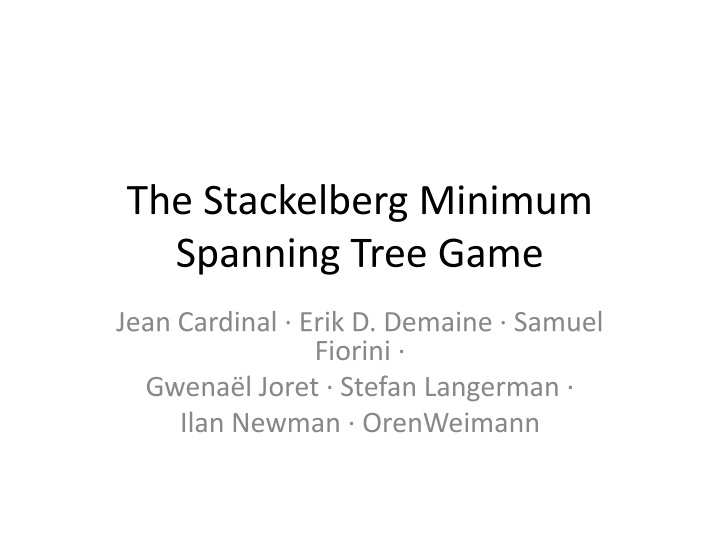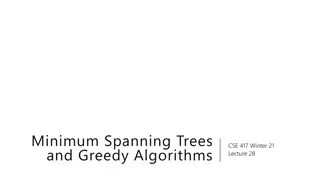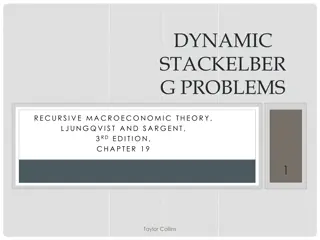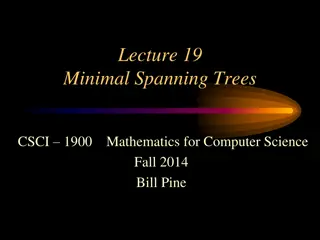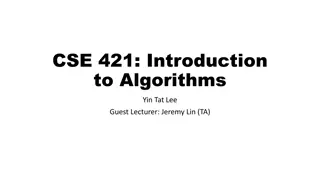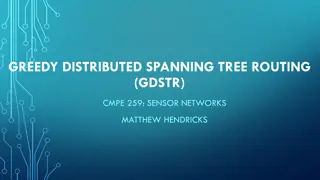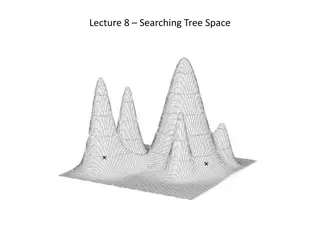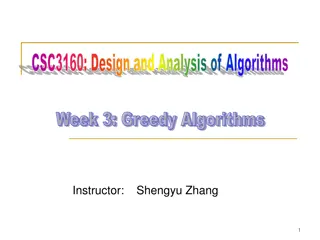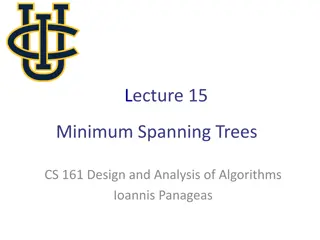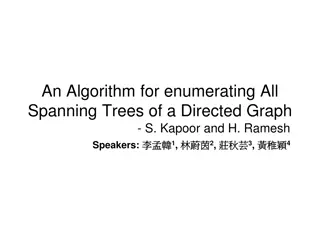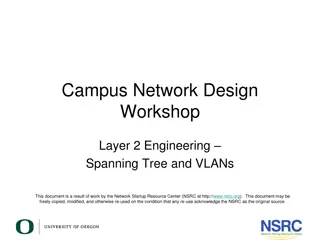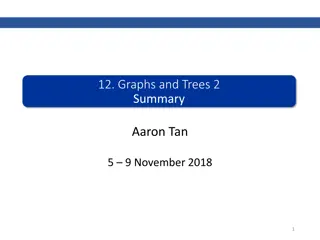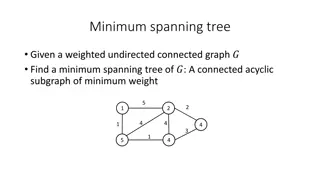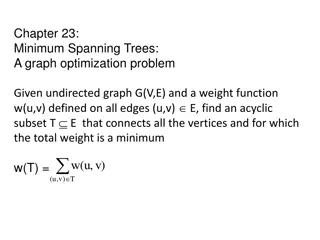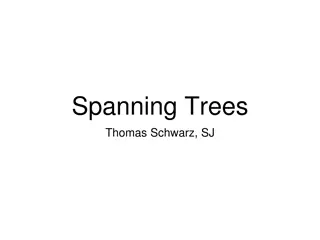Stackelberg Minimum Spanning Tree Game Overview
This content provides an in-depth overview of the Stackelberg Minimum Spanning Tree Game, discussing its introduction, basic results, complexity, inapproximability, and more. It delves into the concept of a graph with red and blue edges, the players' roles, and the game's strategic elements. The discussion on APX-hard problems, polynomial-time approximation schemes, and the relationship to P vs. NP complexity adds depth to understanding this game theory concept.
Download Presentation

Please find below an Image/Link to download the presentation.
The content on the website is provided AS IS for your information and personal use only. It may not be sold, licensed, or shared on other websites without obtaining consent from the author.If you encounter any issues during the download, it is possible that the publisher has removed the file from their server.
You are allowed to download the files provided on this website for personal or commercial use, subject to the condition that they are used lawfully. All files are the property of their respective owners.
The content on the website is provided AS IS for your information and personal use only. It may not be sold, licensed, or shared on other websites without obtaining consent from the author.
E N D
Presentation Transcript
The Stackelberg Minimum Spanning Tree Game Jean Cardinal Erik D. Demaine Samuel Fiorini Gwena l Joret Stefan Langerman Ilan Newman OrenWeimann
Outline Introduction Basic results Complexity and Inapproximability The best out-of-k algorithm Linear programing relaxation
Introduction A graph with red and blue edges. Red edges has a fixed cost(representing the competitor s prices). The first player chooses an assignment of prices to the blue edges. The second player then buys the cheapest possible minimum spanning tree, using any combination of red and blue edges. Stackelberg Minimum Spanning Tree problem (STACKMST)
APX-hard APX (an abbreviation of "approximable") is the set of NP optimization problems that allow polynomial-time approximation algorithms with approximation ratio bounded by a constant (or constant-factor approximation algorithms for short).
APX-hard If there is a polynomial-time algorithm to solve a problem within every fixed percentage greater than zero (one algorithm for each percentage), then the problem is said to have a polynomial-time approximation scheme (PTAS).
APX-hard Unless P=NP, it can be shown that there are problems that are in APX but not in PTAS; that is, problems that can be approximated within some constant factor, but not every constant factor.
APX-hard A problem is said to be APX-hard if there is a PTAS reduction from every problem in APX to that problem, and to be APX-complete if the problem is APX-hard and also in APX. As a consequence of P NP PTAS APX, P NP no APX-hard problem is in PTAS.
Step of the game We are given an undirected graph1 G = (V ,E) whose edge set is partitioned into a red edge set R and a blue edge set B. Each red edge e R has a nonnegative fixed cost c(e) (the best competitor s price). The leader owns every blue edge e B and has to set a price p(e) for each of these edges.
Evaluation A spanning tree T is a minimum spanning tree (MST) if its total weight is minimum. The revenue of T is then
Assumption we assume that the graph contains a spanning tree whose edges are all red; otherwise, there is a cut consisting only of blue edges and the optimum value is unbounded. we assume that among all edges of the same weight, blue edges are always preferred to red edges; this is a standard assumption.
Related work similar pricing problem, where one wants to price the edges in B and the customer wants to construct a shortest path between two vertices instead of a spanning tree. NP-hard and O(log |B|)-approximable
Related work To find the best prices for a set of items, after bidders have announced their preferences in the form of subset valuations. Envy-free pricing, in particular, can be viewed as a simple Stackelberg game. APX-hardness and approximability.
We will show STACKMST is APX-hard, even if there are only two red costs. STACKMST is O(log n)-approximable, and is O(1)- approximable when the red costs either fall in a constant-size range or have a constant number of distinct values. The integrality gap of a natural integer linear programming formulation asymptotically matches the approximation guarantee of Best-out-of-k.
Lemma 1 In every optimal price function, the price assigned to the blue edges appearing in some MST belong to the set {c(e) : e R} 1 2 2 3 4 5 1 2 2 2 4 5
Lemma 2 Consider a price function p, a corresponding minimum spanning tree T, and let F = E(T) B. Then for every e F, we have p(e) min e E(C) Rc( e) C C(F,e)max
eE(C)Rc( e) p(e) min C C(F,e)max
Lemma 3 Let p be an optimal price function and T be a corresponding MST. Suppose that there exists a red edge in T and a blue edge f not in T such that e belongs to the unique cycle C in T+f. Then there exists a blue edge f distinct from f in C such that c(e)< p( f ) p(f)
Complexity and Inapproximability B97902011
Hardness I Proof idea: Reduction from SetCover
APX (approximable) A problem is said to be APX-hard if there is a PTAS reduction from every problem in APX to that problem A problem is APX-complete if the problem is APX-hard and also in APX If P NP APX-hard problem is not in PTAS
Hardness II Proof idea: Reduction from VertexCover in graphs with 3 n = E + 1 m = V r = n + 2m - s - 1
Linear Programming Relaxation R99922107
In this section, we give an integer programming formulation for the problem and study its linear programming relaxation. For each j = 1, , k, and each blue edge e B we define a variable xj,e xj,e= 1 means that the blue edge e appears in T , with a price p(e) of at least cj
Some intuition let F be the set of blue edges appearing in T , and let Fj= {e F : p(e) cj } F (= F1) must obviously be a forest. Fj(j {2, , k}) must be a forest in the graph where every component of (V ,Rj-1) has been contracted, since otherwise we could swap in T some edge of Fjwith an edge in Rj-1.
if a cycle C of the graph is such that every red edge in C has cost at most cj-1and some blue edge f of C appears in T with a price at least cj, then there must be another blue edge of C that is not included in T . 1 2 2 3
Proposition 1 The integer program above is a formulation of STACKMST. claim E(T) B = F and that the revenue of T is exactly the objective value for x. let F = {e B : x1,e= 1} For e F, let p(e) = cjif j is the last index for which xj,e = 1 and, for e B F, let p(e)= .
Proof of Proposition 1 Assume that all edges e F of price less than cjare in T , for some j 2. Consider some edge f with p(f) = cj. Suppose that f is not in T . This means that there exists a cycle in G consisting of blue edges of price at most cjand of red edges of price at most cj 1. But then (5) is violated, a contradiction. all edges of F belong to T .
We define a vector x as follows: for e B, xi,e= 1 if e F and p(e) ci , otherwise xi,e= 0. It is easily checked that the revenue given by p equals the objective function of the IP for x. If x violates (5) for some e F, then e also violates the min-max formula given in Lemma 2. This completes the proof.
Proposition 2 The LP can be separated in polynomial time. For fixed j, (4) can be separated in polynomial time using standard techniques for the forest polytope. (6) can obviously be separated in polynomial time.
(5) can be rewritten as Thus, for each fixed j and f = ab, (5) can be separated by finding a shortest ab-path in the graph (V , (B Rj 1) f ) where every red edge has weight 0 and every blue edge e has weight 1 x1,e.
Proposition 3 We have (LP) min{k, 1+lnb, 1+lnW} (IP), where b denotes the number of blue edges, and W = ck/c1is the maximum ratio between red costs.
Letting q = maxi=1,...,kAi cidenote the revenue given by the Best-out-of-k algorithm, we deduce and, letting Ak+1= 0,
Proposition 4 The integrality gap of the LP is k on instances with k distinct costs; (lnW) on instances with maximum ratio between red costs W, and (lnb) on instances with b blue edges.
conclusion The integrality gap of a natural integer linear programming formulation asymptotically matches the approximation guarantee of Best- out-of-k. Thus, any approximation algorithm based on the linear programming relaxation of our integer program (or any weaker relaxation) cannot do better than Best-out-of-k.
